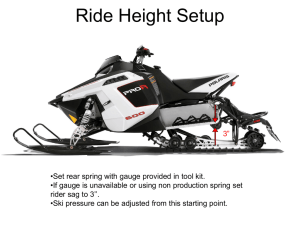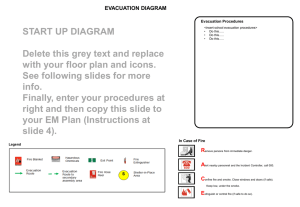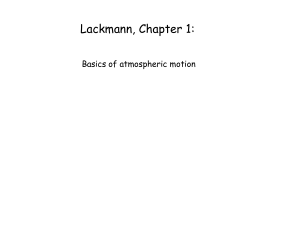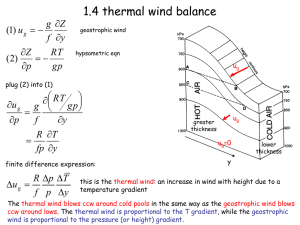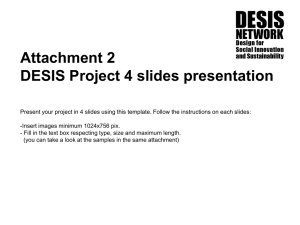Formulation of the dynamical core and physics
advertisement
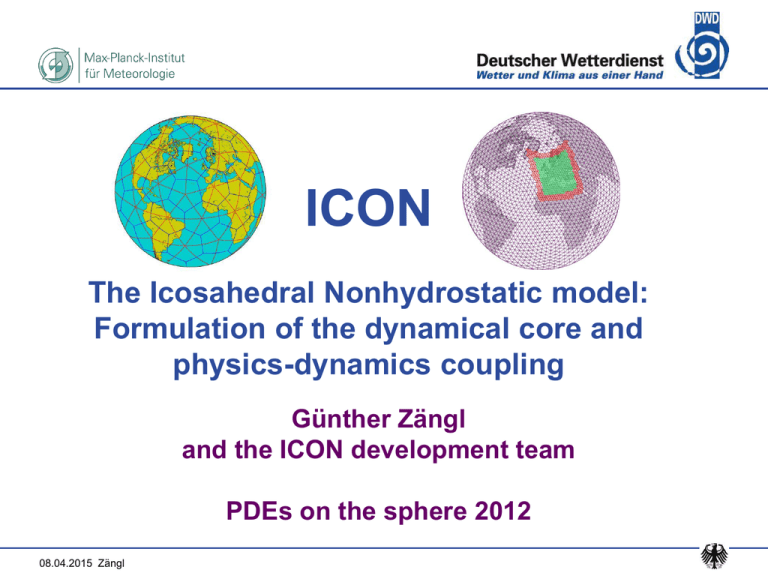
ICON The Icosahedral Nonhydrostatic model: Formulation of the dynamical core and physics-dynamics coupling Günther Zängl and the ICON development team PDEs on the sphere 2012 08.04.2015 Zängl Outline Introduction: Main goals of the ICON project The dynamical core and physics-dynamics coupling Selected results: from dycore tests to NWP applications Summary and conclusions 08.04.2015 Zängl ICON ICON = ICOsahedral Nonhydrostatic model Joint development project of DWD and Max-Planck-Institute for Meteorology for the next-generation global NWP and climate modeling system Nonhydrostatic dynamical core on an icosahedral-triangular C-grid; coupled with (almost) full set of physics parameterizations Two-way nesting with capability for multiple nests per nesting level; vertical nesting, one-way nesting mode and limited-area mode are also available 08.04.2015 Zängl ICON Primary development goals Better conservation properties (air mass, mass of trace gases and moisture, consistent transport of tracers) Grid nesting in order to replace both GME (global forecast model, mesh size 20 km) and COSMO-EU (regional model, mesh size 7 km) in the operational suite of DWD Applicability on a wide range of scales in space and time down to mesh sizes that require a nonhydrostatic dynamical core Scalability and efficiency on massively parallel computer architectures with O(104+) cores At MPI-M: Develop an ocean model based on ICON grid structures and operators; Use limited-area mode of ICON to replace regional climate model REMO. Later in this decade: participate in the seasonal prediction project EURO-SIP 08.04.2015 Zängl Nonhydrostatic equation system (dry adiabatic) vn vn K c pd v w f vt n z n t w w g c pd v (vn w) w vn w z z t vn,w: normal/vertical velocity component (v ) 0 : density t v: Virtual potential temperature v K: horizontal kinetic energy (v v ) 0 t : vertical vorticity component : Exner function blue: independent prognostic variables 08.04.2015 Zängl Numerical implementation (dynamical core) • Two-time-level predictor-corrector time stepping scheme; for efficiency reasons, not all terms are evaluated in both sub-steps • For thermodynamic variables: Miura 2nd-order upwind scheme (centered differences) for horizontal (vertical) flux reconstruction; 5-point averaged velocity to achieve (nearly) second-order accuracy for divergence • implicit treatment of vertically propagating sound waves, but explicit time-integration in the horizontal (at sound wave time step; not split-explicit); larger time step (usually 4x or 5x) for tracer advection / fast physics • For numerical convenience, the thermodynamic equation is reformulated to an equation for Exner pressure • Numerical filter: fourth-order divergence damping 08.04.2015 Zängl Numerical implementation (tracer advection) • Finite-volume tracer advection scheme (Miura) with 2nd-order and 3rd-order accuracy for horizontal advection; extension for CFL values slightly larger than 1 available • 2nd-order MUSCL and 3rd-order PPM for vertical advection with extension to CFL values much larger than 1 (partial-flux method) • Monotonous and positive-definite flux limiters • Option to turn off advection of cloud and precipitation variables (and moisture physics) in the stratosphere • Option for (QV) substepping in the stratosphere 08.04.2015 Zängl Numerical implementation (physics-dynamics coupling) • Fast-physics processes: incremental update in the sequence: saturation adjustment, turbulence, cloud microphysics, saturation adjustment, surface coupling • Slow-physics processes (convection, cloud cover diagnosis, radiation, orographic blocking, sub-grid-scale gravity waves): tendencies are added to the right-hand side of the velocity and Exner pressure equation • Diabatic heating rates related to phase changes and radiation are consistently treated at constant volume 08.04.2015 Zängl Special discretization of horizontal pressure gradient (apart from conventional method; Zängl 2012, MWR) • Precompute for each edge (velocity) point at level the grid layers into which the edge point would fall in the two adjacent cells A S 08.04.2015 Zängl dashed lines: main levels pink: edge (velocity) points blue: cell (mass) points Discretization of horizontal pressure gradient • Reconstruct the Exner function at the mass points using a quadratic Taylor expansion, starting from the point lying in the model layer closest to the edge point c 1 g v 2 ~ c c ( ze zc ) ( z z ) e c 2 z 2 c p v z • Note: the quadratic term has been approximated using the hydrostatic equation to avoid computing a second derivative • Treatment at slope points where the surface is intersected: x 08.04.2015 Zängl S x v (zS z A ) 2 c p v x A g A Selected experiments and results • Highly idealized tests with an isolated steep mountain, mesh size 300 m: atmosphere-at-rest and generation of nonhydrostatic gravity waves • Jablonowski-Williamson baroclinic wave test with/without grid nesting • DCMIP tropical cyclone test with/without grid nesting • Real-case tests with interpolated IFS analysis data 08.04.2015 Zängl atmosphere-at-rest test, isothermal atmosphere, results at t = 6h vertical wind speed (m/s), potential temperature (contour interval 4 K) circular Gaussian mountain, e-folding width 2 km, height: 3.0 km (left), 7.0 km (right) maximum slope: 1.27 (52°) / 2.97 (71°) 08.04.2015 Zängl ambient wind speed 10 m/s, isothermal atmosphere, results at t = 6h vertical (left) / horizontal (right) wind speed (m/s), potential temperature (contour interval 4 K) circular Gaussian mountain, e-folding width 2 km, height: 7.0 km maximum slope: 2.97 (71°) 08.04.2015 Zängl ambient wind speed 25 m/s, isothermal atmosphere, results at t = 6h vertical (left) / horizontal (right) wind speed (m/s), potential temperature (contour interval 4 K) circular Gaussian mountain, e-folding width 2 km, height: 7.0 km maximum slope: 2.97 (71°) 08.04.2015 Zängl ambient wind speed 7.5 m/s, multi-layer atmosphere, results at t = 6h vertical (left) / horizontal (right) wind speed (m/s), potential temperature (contour interval 2 K) 3D Schär mountain, height: 4.0 km, peak-to-peak distance 4.0 km maximum slope: 2.73 (70°) 08.04.2015 Zängl Jablonowski-Wiliamson test, surface pressure (Pa) after 10 days 160 km 80 km 40 km 08.04.2015 Zängl Jablonowski-Wiliamson test, vertical wind at 1.5 km AGL (m/s) after 10 days 160 km 80 km 40 km 08.04.2015 Zängl Jablonowski-Wiliamson test, surface pressure (Pa) after 10 days 160 km 80 km 160/80 km, two-way nesting 08.04.2015 Zängl DCMIP tropical cyclone test with NWP physics schemes, evolution over 12 days Absolute horizontal wind speed (m/s) Left: single domain, 56 km; right: two-way nesting, 56 km / 28 km 08.04.2015 Zängl Real-case forecasts initialized with interpolated IFS analyses: mean sea-level pressure 2 Jan 2012, 00 UTC + 168 h 08.04.2015 Zängl 18 Jun 2012, 00 UTC + 168 h Real-case forecasts initialized with interpolated IFS analyses: temperature at 10 m AGL 2 Jan 2012, 00 UTC + 168 h 08.04.2015 Zängl 18 Jun 2012, 00 UTC + 168 h Real-case forecasts initialized with interpolated IFS analyses: 7-day accumulated precipitation 2 Jan 2012, 00 UTC + 168 h 08.04.2015 Zängl 18 Jun 2012, 00 UTC + 168 h WMO standard verification against IFS analysis: 500 hPa geopotential, NH blue: GME 40 km with IFS analysis, red: ICON 40 km with IFS analysis 08.04.2015 Zängl WMO standard verification against IFS analysis: 500 hPa geopotential, SH blue: GME 40 km with IFS analysis, red: ICON 40 km with IFS analysis 08.04.2015 Zängl Summary and conclusions • The dynamical core of ICON combines efficiency, high numerical stability and improved conservation properties • The two-way nesting induces very weak disturbances, supports vertical nesting and a limited-area mode • Forecast quality with full physics coupling is comparable with the operational GME even though systematic testing and tuning is only in its initial phase • Next major step: coupling with data assimilation Visit also the ICON posters by Reinert et al. and Ripodas et al. 08.04.2015 Zängl

